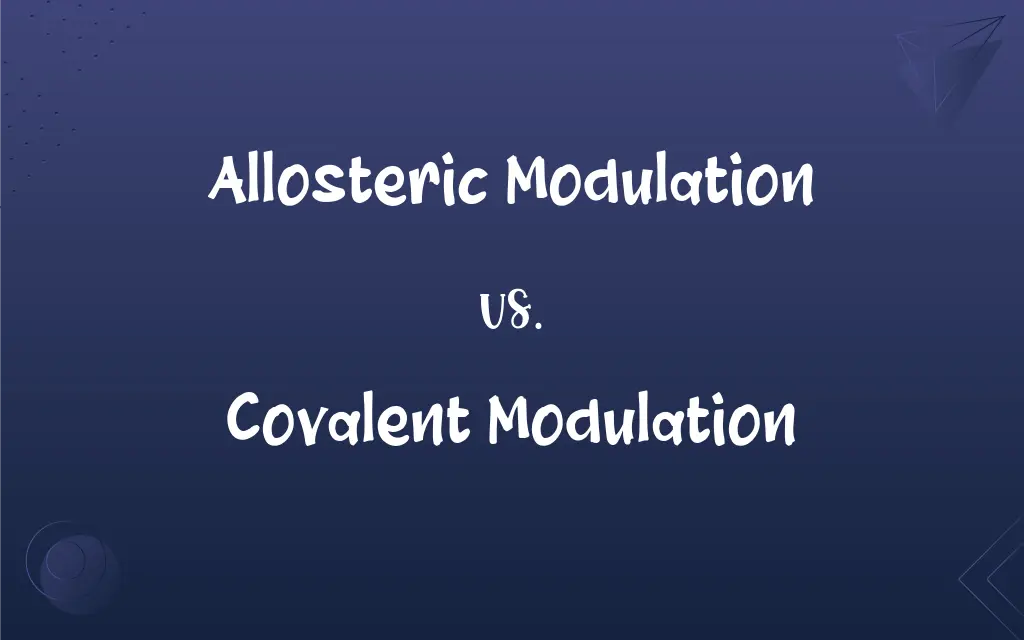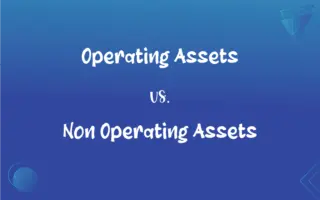Allosteric Modulation vs. Covalent Modulation: What's the Difference?
Edited by Aimie Carlson || By Janet White || Published on February 22, 2024
Allosteric Modulation refers to regulation of protein function through binding at a site other than the active site. Covalent Modulation refers to regulation of protein activity through covalent attachment of a chemical group.

Key Differences
Allosteric Modulation involves the binding of an effector molecule at a site separate from the enzyme's active site, leading to a change in its activity. Covalent Modulation, in contrast, requires the covalent attachment of a chemical group, like a phosphate group, to the protein, altering its activity.
In Allosteric Modulation, the effector molecules cause conformational changes in the protein, leading to activation or inhibition. Covalent Modulation, however, often involves enzymatic reactions for the addition or removal of the modifying group, typically resulting in a more stable and lasting change in protein function.
Allosteric Modulation is usually reversible and can be fine-tuned by the concentration of the allosteric effector. Covalent Modulation often requires additional enzymes for reversing the modification, like phosphatases in the case of phosphorylation, making it a more complex regulatory mechanism.
A key feature of Allosteric Modulation is its role in facilitating rapid and dynamic regulatory responses in cellular processes. Covalent Modulation, due to its stability and the involvement of enzymatic steps, is typically associated with longer-term regulatory changes in the cell.
Allosteric Modulation is exemplified in hemoglobin's oxygen-binding regulation, where oxygen binding alters its affinity for more oxygen. Covalent Modulation is commonly seen in the regulation of enzyme activities in metabolic pathways, such as glycogen phosphorylase being activated by phosphorylation.
ADVERTISEMENT
Comparison Chart
Binding Site
Non-active site
Active or specific sites
Mechanism
Conformational change
Chemical group attachment
Reversibility
Often reversible
Requires specific enzymes for reversal
Response Time
Rapid and dynamic
Usually slower, more stable
Example
Hemoglobin oxygen regulation
Activation of glycogen phosphorylase
ADVERTISEMENT
Allosteric Modulation and Covalent Modulation Definitions
Allosteric Modulation
A reversible form of protein regulation through non-covalent binding.
GABA receptors are subject to allosteric modulation by various neurotransmitters.
Covalent Modulation
Enzyme activity regulation by stable, covalent changes.
In covalent modulation, enzymes like kinases add phosphate groups to target proteins, altering their function.
Allosteric Modulation
Regulation of protein function via non-active site binding.
Allosteric modulation occurs when oxygen binds to hemoglobin, increasing its affinity for more oxygen.
Covalent Modulation
Modification of protein structures through covalent bonding.
Covalent modulation plays a critical role in regulating the cell cycle by modifying key proteins.
Allosteric Modulation
Inducing functional changes in proteins by effector molecule binding.
In allosteric modulation, a small molecule's binding can significantly alter an enzyme's activity.
Covalent Modulation
Alteration of protein function via covalent attachment of molecules.
Enzyme activity can be increased or decreased through covalent modulation by attaching phosphate groups.
Allosteric Modulation
Dynamic control of protein functions via allosteric site interaction.
Allosteric modulation allows for the fine-tuning of protein activities in response to cellular signals.
Covalent Modulation
Regulation of protein activity through the addition of a chemical group.
Covalent modulation often involves phosphorylation, as seen in many signaling pathways.
Allosteric Modulation
Modulation of enzyme activity through structural alteration by an external effector.
Allosteric modulation helps regulate enzymes in metabolic pathways without altering the active site.
Covalent Modulation
Long-term control of protein functions via covalent alterations.
Glycogen metabolism is regulated through covalent modulation of glycogen synthase and phosphorylase.
FAQs
What is allosteric modulation?
It's the regulation of a protein's function through binding at a site other than the active site.
What is covalent modulation?
It involves the regulation of protein activity through the covalent attachment of a chemical group.
How is covalent modulation reversed?
Through specific enzymes, like phosphatases, which remove the covalent modifications.
Is covalent modulation a rapid process?
It's typically slower and more stable compared to allosteric modulation.
How does allosteric modulation alter protein activity?
By causing conformational changes in the protein structure.
What is a common form of covalent modulation?
Phosphorylation is a common form, where phosphate groups are added to proteins.
What kind of binding occurs in allosteric modulation?
Non-covalent binding at a site separate from the active site.
Is allosteric modulation reversible?
Yes, it is often reversible and depends on the concentration of the effector molecule.
Can allosteric modulation be fine-tuned?
Yes, it can be finely regulated by varying the concentration of allosteric effectors.
What is an example of allosteric modulation in the body?
Hemoglobin's oxygen-binding regulation is a classic example.
Where is covalent modulation commonly seen?
It's seen in the regulation of enzymes in metabolic pathways, like in glycogen metabolism.
What enzymes are involved in covalent modulation?
Enzymes like kinases and phosphatases play a key role.
Are both forms of modulation essential for cell function?
Yes, both play crucial roles in regulating various cellular processes.
Are allosteric sites the same as active sites?
No, they are distinct and separate from the active sites.
What role does allosteric modulation play in metabolism?
It helps regulate enzymes involved in various metabolic pathways.
What kind of chemical groups are involved in covalent modulation?
Groups like phosphate, methyl, or acetyl groups.
Can allosteric modulators be drugs?
Yes, many drugs act as allosteric modulators to regulate protein function.
How does covalent modulation affect signaling pathways?
It plays a significant role in the regulation and propagation of cellular signals.
Can covalent modulation be targeted by medications?
Yes, drugs can target enzymes involved in covalent modulation.
Does allosteric modulation involve enzymes?
Not directly; it's more about the effector molecule binding.
About Author
Written by
Janet WhiteJanet White has been an esteemed writer and blogger for Difference Wiki. Holding a Master's degree in Science and Medical Journalism from the prestigious Boston University, she has consistently demonstrated her expertise and passion for her field. When she's not immersed in her work, Janet relishes her time exercising, delving into a good book, and cherishing moments with friends and family.
Edited by
Aimie CarlsonAimie Carlson, holding a master's degree in English literature, is a fervent English language enthusiast. She lends her writing talents to Difference Wiki, a prominent website that specializes in comparisons, offering readers insightful analyses that both captivate and inform.































































